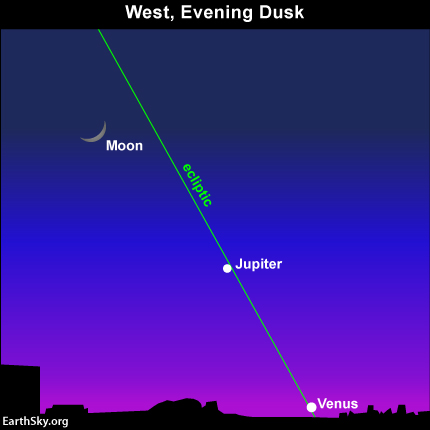As you celebrate this upcoming Memorial Day weekend, take some time to appreciate an interesting sight in the sky — the gathering of Mercury, Venus and Jupiter low in the west-northwest at dusk.
Right now, you notice Jupiter setting in the west at dusk. It outshines all stars we ever see at night, so it’s quite visible even during twilight. Because Earth is about to pass around the far side of the Sun from Jupiter’s position, we see Jupiter get a little lower to the horizon each night this month.
 Image courtesy of earthsky.org
Image courtesy of earthsky.org
Perhaps, if your northwest horizon is clear enough, you will also notice Venus below and a bit to the right of Jupiter. In late January 2013, we lost sight of Venus as it began to pass around the far side of the Sun. Now in May 2013, it has begun to come from behind the Sun so that we see it again. Unlike Jupiter, then, Venus gets a little higher in the sky each night. Venus will be an evening star for the rest of 2013.
Mercury is usually invisible to us because it is always in the Sun’s general direction. Only rarely is Mercury far enough from the Sun in our sky to be above the horizon while the Sun is not. June 2013 is one of those exceptional moments. As May 2013 ends, Mercury also enters the evening sky alongside Venus.
On May 23, Mercury is directly beside Venus as both planets are 5 degrees (the width of three fingers, held at arm’s length) to the lower right of Jupiter. By May 26, Mercury and Venus have caught up with Jupiter to form a triangle about two degrees wide. (Jupiter and Mercury are side by side; Venus is the ‘apex’ pointing down.) On the next night, Memorial Day, we see Venus and Jupiter less then one degree apart, with Mercury about two degrees above them. This will be the closest gathering of any three planets until January 2021.
Keep in mind that to observe any of this, you need a northwest horizon utterly clear of buildings, trees, or other obstacles. You can test your chosen observation site by watching a sunset there. The three planets will appear in the same direction in which the Sun sets. If you can watch sunset all the way until the Sun sets, you’ve picked a good site for observing the May 2013 planet gathering.
Keep in mind that Venus and Jupiter outshine all stars we ever see at night. This means that they become quite visible in twilight. Once you’ve picked a good observation spot, you can begin looking for Venus and Jupiter in twilight (around 8:30 p.m.) without waiting until twilight ends (about 9:15 p.m. at the end of May in Houston).
During June 2013, Mercury and Venus remain in the western sky at dusk, while Jupiter drops into the glare of the Sun. At first, the faster Mercury races out ahead of Venus and is thus higher in the sky. By mid-month, though, Mercury has begun to come around to our side of the Sun, so we see it slow down and head back towards the Sun. On June 18, Mercury and Venus are side by side once again. Then Mercury drops back into the Sun’s glare, leaving Venus as the planet visible in the west at dusk for the rest of 2013.






